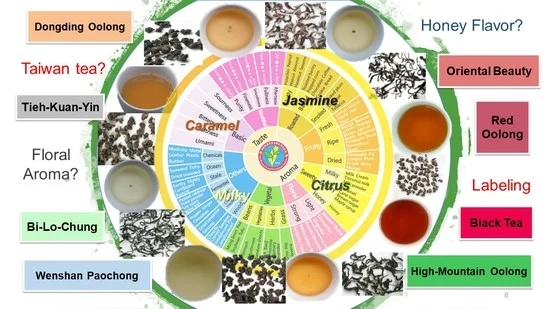Using Sensory Wheels to Characterize Consumers’ Perception for Authentication of Taiwan Specialty Teas
Abstract
1. Introduction
2. Materials and Methods
2.1. Experimental Design and a Focus Group
2.2. Sensory Evaluation Panel
2.3. Collection of Tea Samples
2.4. Preparation of Tea Infusions and Sensory Evaluation
2.5. Survey of Consumers’ Acceptance of Aroma Descriptors in the Sensory Wheels
3. Results and Discussion
3.1. Authentication and Sensometrics of Eight Taiwan Specialty Teas
3.2. Sensory Wheels to Characterize the Six Flavor Categories in Taiwan Teas
3.3. Standardizations on Tea Evaluation with Sensory Wheels
3.4. Aroma Profiling of Taiwan Specialty Teas by Consumers’ Perception with the Sensory Wheels
3.5. Development of Sensory Wheels to Enhance the Tea Economics
3.6. Limitations of this Study and Future Applications
4. Conclusions
Author Contributions
Funding
Informed Consent Statement
Data Availability Statement
Acknowledgments
Conflicts of Interest
Appendix A
|
|
|
|
|
|
|
|
References
- Chang, K. Word Tea Production and Trade: Current and Future Development; Food and Agriculture Organization of the United Nations: Rome, Italy, 2015. [Google Scholar]
- Zhang, J. A Transnational Flow of the Art of Tea: The Paradox of Cultural Authenticity in Taiwan. Asia Pac. J. Anthropol. 2018, 19, 1–18. [Google Scholar] [CrossRef]
- Reid, D. The Art and Alchemy of Chinese Tea; Singing Dragon: London, UK, 2011. [Google Scholar]
- Krider, R.E.; Li, T.; Liu, Y.; Weinberg, C.B. Demand and distribution relationships in the ready-to-drink iced tea market: A graphical approach. Mark. Lett. 2008, 19, 1–12. [Google Scholar] [CrossRef][Green Version]
- Lei, L. The supply chain in East Asia. IDE Discuss. Pap. 2016, 571. Available online: https://ideas.repec.org/p/jet/dpaper/dpaper571.html (accessed on 15 April 2020).
- Peluso, I.; Serafini, M. Antioxidants from black and green tea: From dietary modulation of oxidative stress to pharmacological mechanisms. Br. J. Pharm. 2017, 174, 1195–1208. [Google Scholar] [CrossRef] [PubMed]
- Chiu, Y. Environmental Implications of Taiwanese Oolong Tea and the Opportunities of Impact Reduction. Sustainability 2019, 11, 6042. [Google Scholar] [CrossRef]
- Paul, T.; Mondal, S. A strategic analysis of tea leaves supply chain before manufacturing—A case in Assam. Benchmark. Int. J. 2019, 26, 246–270. [Google Scholar] [CrossRef]
- Lahne, J.; Abdi, H.; Collins, T.; Heymann, H. Bourbon and Rye Whiskeys Are Legally Distinct but Are Not Discriminated by Sensory Descriptive Analysis. J. Food Sci. 2019, 84, 629–639. [Google Scholar] [CrossRef]
- Fang, W.; Meinhardt, L.W.; Tan, H.; Zhou, L.; Mischke, S.; Wang, X.; Zhang, D. Identification of the varietal origin of processed loose-leaf tea based on analysis of a single leaf by SNP nanofluidic array. Crop. J. 2016, 4, 304–312. [Google Scholar] [CrossRef][Green Version]
- Lv, H.-P.; Zhang, Y.-J.; Lin, Z.; Liang, Y.-R. Processing and chemical constituents of Pu-erh tea: A review. Food Res. Int. 2013, 53, 608–618. [Google Scholar] [CrossRef]
- Stilo, F.; Tredici, G.; Bicchi, C.; Robbat, A., Jr.; Morimoto, J.; Cordero, C. Climate and Processing Effects on Tea (Camellia sinensis L. Kuntze) Metabolome: Accurate Profiling and Fingerprinting by Comprehensive Two-Dimensional Gas Chromatography/Time-of-Flight Mass Spectrometry. Molecules 2020, 25, 2447. [Google Scholar] [CrossRef]
- Gonzalez-Dominguez, R. Food Authentication: Techniques, Trends and Emerging Approaches. Foods 2020, 9, 346. [Google Scholar] [CrossRef] [PubMed]
- Epova, E.N.; Bérail, S.; Séby, F.; Barre, J.P.G.; Vacchina, V.; Médina, B.; Sarthou, L.; Donard, O.F.X. Potential of lead elemental and isotopic signatures for authenticity and geographical origin of Bordeaux wines. Food Chem. 2020, 303, 125277. [Google Scholar] [CrossRef] [PubMed]
- Yang, J.E.; Lee, J. Consumer perception and liking, and sensory characteristics of blended teas. Food Sci. Biotechnol. 2020, 29, 63–74. [Google Scholar] [CrossRef] [PubMed]
- Liou, B.K.; Jaw, Y.M.; Chuang, G.C.; Yau, N.N.J.; Zhuang, Z.Y.; Wang, L.F. Important Sensory, Association, and Postprandial Perception Attributes Influencing Young Taiwanese Consumers’ Acceptance for Taiwanese Specialty Teas. Foods 2020, 9, 100. [Google Scholar] [CrossRef]
- Mendes da Silva, T.; Torello Marinoni, D.; Peano, C.; Roberta Giuggioli, N. A New Sensory Approach Combined with a Text-Mining Tool to Create a Sensory Lexicon and Profile of Monovarietal Apple Juices. Foods 2019, 8, 608. [Google Scholar] [CrossRef]
- Lee, J.; Chambers, D.H. A Lexicon for Flavor Descriptive Analysis of Green Tea. J. Sens. Stud. 2007, 22, 256–272. [Google Scholar] [CrossRef]
- Wu, P.K.; Tai, W.C.; Choi, R.C.; Tsim, K.W.; Zhou, H.; Liu, X.; Jiang, Z.H.; Hsiao, W.L. Chemical and DNA authentication of taste variants of Gynostemma pentaphyllum herbal tea. Food Chem. 2011, 128, 70–80. [Google Scholar] [CrossRef] [PubMed]
- Wang, L.-F.; Lee, J.-Y.; Chung, J.-O.; Baik, J.-H.; So, S.; Park, S.-K. Discrimination of teas with different degrees of fermentation by SPME–GC analysis of the characteristic volatile flavour compounds. Food Chem. 2008, 109, 196–206. [Google Scholar] [CrossRef]
- Huang, H.; Kfoury, N.; Orians, C.M.; Griffin, T.; Ahmed, S.; Cash, S.B.; Stepp, J.R.; Xue, D.; Long, C.; Robbat, A., Jr. 2014–2016 seasonal rainfall effects on metals in tea (Camelia sinensis (L.) Kuntze). Chemosphere 2019, 219, 796–803. [Google Scholar] [CrossRef]
- Suwonsichon, S. The Importance of Sensory Lexicons for Research and Development of Food Products. Foods 2019, 8, 27. [Google Scholar] [CrossRef]
- Chun, S.; Chambers, E.T.; Han, I. Development of a Sensory Flavor Lexicon for Mushrooms and Subsequent Characterization of Fresh and Dried Mushrooms. Foods 2020, 9, 980. [Google Scholar] [CrossRef] [PubMed]
- Cortes-Dieguez, S.; Otero-Cervino, C.; Rodeiro-Mougan, H.; Feijoo-Mateo, J.A. Quantitative Descriptive Analysis of Traditional Herbal and Coffee Liqueurs made with Grape Marc Spirit (Orujo). Foods 2020, 9, 753. [Google Scholar] [CrossRef]
- ISO 8586 Sensory Analysis—General Guidelines for the Selection, Training and Monitoring of Selected Assessors and Expert Sensory Assessors; ISO: Geneva, Switzerland, 2012.
- ISO 3103 Tea-Preparation of Liquor for Use in Sensory Tests; ISO: Geneva, Switzerland, 1980.
- Zeng, L.; Zhou, X.; Su, X.; Yang, Z. Chinese oolong tea: An aromatic beverage produced under multiple stresses. Trends Food Sci. Technol. 2020, 106, 242–253. [Google Scholar] [CrossRef]
- Zhao, X.; Chen, S.; Wang, S.; Shan, W.; Wang, X.; Lin, Y.; Su, F.; Yang, Z.; Yu, X. Defensive Responses of Tea Plants (Camellia sinensis) Against Tea Green Leafhopper Attack: A Multi-Omics Study. Front. Plant Sci. 2020, 10. [Google Scholar] [CrossRef]
- Cho, J.Y.; Mizutani, M.; Shimizu, B.; Kinoshita, T.; Ogura, M.; Tokoro, K.; Lin, M.L.; Sakata, K. Chemical profiling and gene expression profiling during the manufacturing process of Taiwan oolong tea “Oriental Beauty”. Biosci. Biotechnol. Biochem. 2007, 71, 1476–1486. [Google Scholar] [CrossRef]
- Fu, Y.Q.; Wang, J.Q.; Chen, J.X.; Wang, F.; Yin, J.F.; Zeng, L.; Shi, J.; Xu, Y.Q. Effect of baking on the flavor stability of green tea beverages. Food Chem. 2020, 331, 127258. [Google Scholar] [CrossRef] [PubMed]
- Yang, Y.; Zhang, M.; Hua, J.; Deng, Y.; Jiang, Y.; Li, J.; Wang, J.; Yuan, H.; Dong, C. Quantitation of pyrazines in roasted green tea by infrared-assisted extraction coupled to headspace solid-phase microextraction in combination with GC-QqQ-MS/MS. Food Res. Int. 2020, 134, 109167. [Google Scholar] [CrossRef]
- Lee, S.M.; Lee, H.S.; Kim, K.H.; Kim, K.O. Sensory characteristics and consumer acceptability of decaffeinated green teas. J. Food Sci. 2009, 74, S135–S141. [Google Scholar] [CrossRef]
- Ding, Z.; Kuhr, S.; Engelhardt, U.H. Influence of catechins and theaflavins on the astringent taste of black tea brews. Z. Lebensm. Unters. Forsch. 1992, 195, 108–111. [Google Scholar] [CrossRef]
- Zhou, P.; Hu, O.; Fu, H.; Ouyang, L.; Gong, X.; Meng, P.; Wang, Z.; Dai, M.; Guo, X.; Wang, Y. UPLC-Q-TOF/MS-based untargeted metabolomics coupled with chemometrics approach for Tieguanyin tea with seasonal and year variations. Food Chem. 2019, 283, 73–82. [Google Scholar] [CrossRef] [PubMed]
- Ivanisova, E.; Menhartova, K.; Terentjeva, M.; Harangozo, L.; Kantor, A.; Kacaniova, M. The evaluation of chemical, antioxidant, antimicrobial and sensory properties of kombucha tea beverage. J. Food Sci. Technol. 2020, 57, 1840–1846. [Google Scholar] [CrossRef]
- Aboulwafa, M.M.; Youssef, F.S.; Gad, H.A.; Sarker, S.D.; Nahar, L.; Al-Azizi, M.M.; Ashour, M.L. Authentication and discrimination of green tea samples using UV-vis, FTIR and HPLC techniques coupled with chemometrics analysis. J. Pharm. Biomed. Anal. 2019, 164, 653–658. [Google Scholar] [CrossRef] [PubMed]
- Ni, H.; Jiang, Q.X.; Zhang, T.; Huang, G.L.; Li, L.J.; Chen, F. Characterization of the Aroma of an Instant White Tea Dried by Freeze Drying. Molecules 2020, 25, 3628. [Google Scholar] [CrossRef]
- Röling, W.F.; Kerler, J.; Braster, M.; Apriyantono, A.; Stam, H.; van Verseveld, H.W. Microorganisms with a taste for vanilla: Microbial ecology of traditional Indonesian vanilla curing. Appl. Environ. Microbiol. 2001, 67, 1995–2003. [Google Scholar] [CrossRef]
- De Pelsmaeker, S.; De Clercq, G.; Gellynck, X.; Schouteten, J.J. Development of a sensory wheel and lexicon for chocolate. Food Res. Int. 2019, 116, 1183–1191. [Google Scholar] [CrossRef] [PubMed]
- Bergamaschi, M.; Cipolat-Gotet, C.; Cecchinato, A.; Schiavon, S.; Bittante, G. Chemometric authentication of farming systems of origin of food (milk and ripened cheese) using infrared spectra, fatty acid profiles, flavor fingerprints, and sensory descriptions. Food Chem. 2020, 305, 125480. [Google Scholar] [CrossRef] [PubMed]
- Labbe, D.; Gilbert, F.; Martin, N. Impact of Olfaction on Taste, Trigeminal, and Texture Perceptions. Chemosens. Percept. 2008, 1, 217–226. [Google Scholar] [CrossRef]
- Vivek, K.; Subbarao, K.V.; Routray, W.; Kamini, N.R.; Dash, K.K. Application of Fuzzy Logic in Sensory Evaluation of Food Products: A Comprehensive Study. Food Bioprocess Technol. 2020, 13, 1–29. [Google Scholar] [CrossRef]
- Hung, Y.-C.; Chen, P.; Chen, L.-Y. Advanced Classification of Coffee Beans with Fatty Acids Profiling to Block Information Loss. Symmetry 2018, 10, 529. [Google Scholar] [CrossRef]
- Lee, J.; Chambers, E., IV; Chambers, D.H.; Chun, S.S.; Oupadissakoon, C.; Johnson, D.E. Consumer Acceptance for Green Tea by Consumers in The United States, Korea and Thailand. J. Sens. Stud. 2010, 25, 109–132. [Google Scholar] [CrossRef]
- De Godoy, R.C.B.; Chambers, E., IV; Yang, G. Development of a preliminary sensory lexicon for mate tea. J. Sens. Stud. 2020, 35, e12570. [Google Scholar] [CrossRef]
- Lee, S.M.; Chung, S.-J.; Lee, O.-H.; Lee, H.-S.; Kim, Y.-K.; Kim, K.-O. Development of Sample Preparation, Presentation Procedure and Sensory Descriptive Analysis of Green Tea. J. Sens. Stud. 2008, 23, 450–467. [Google Scholar] [CrossRef]
- Jin, X. Analysis of Comparative advantages of tea trade between China and Countries along the “Belt and Road Initiative”. IOP Conf. Ser. Earth Environ. Sci. 2019, 310, 052056. [Google Scholar] [CrossRef]
- Chambers, E., IV; Sanchez, K.; Phan, U.X.T.; Miller, R.; Civille, G.V.; Di Donfrancesco, B. Development of a “living” lexicon for descriptive sensory analysis of brewed coffee. J. Sens. Stud. 2016, 31, 465–480. [Google Scholar] [CrossRef]
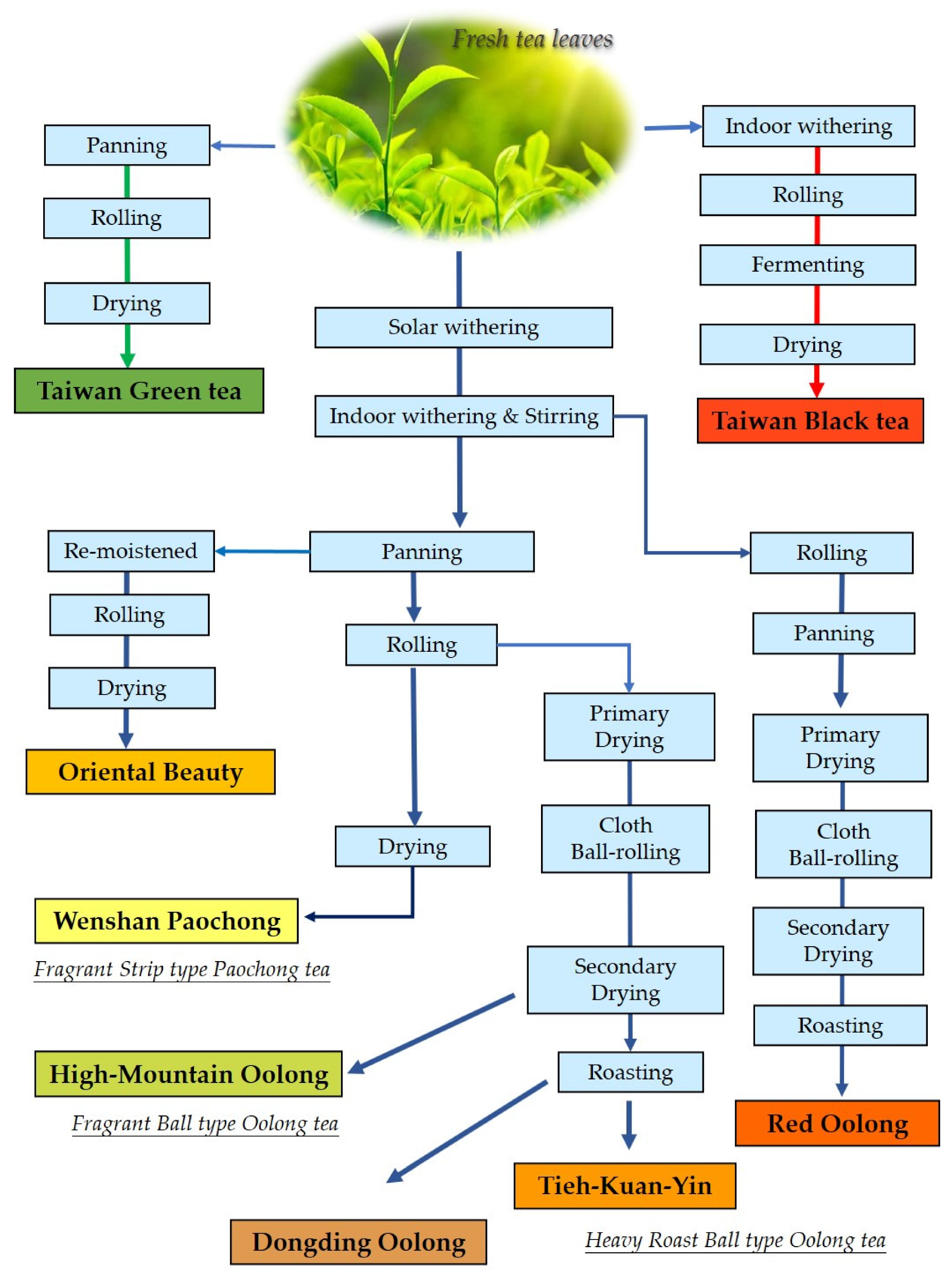
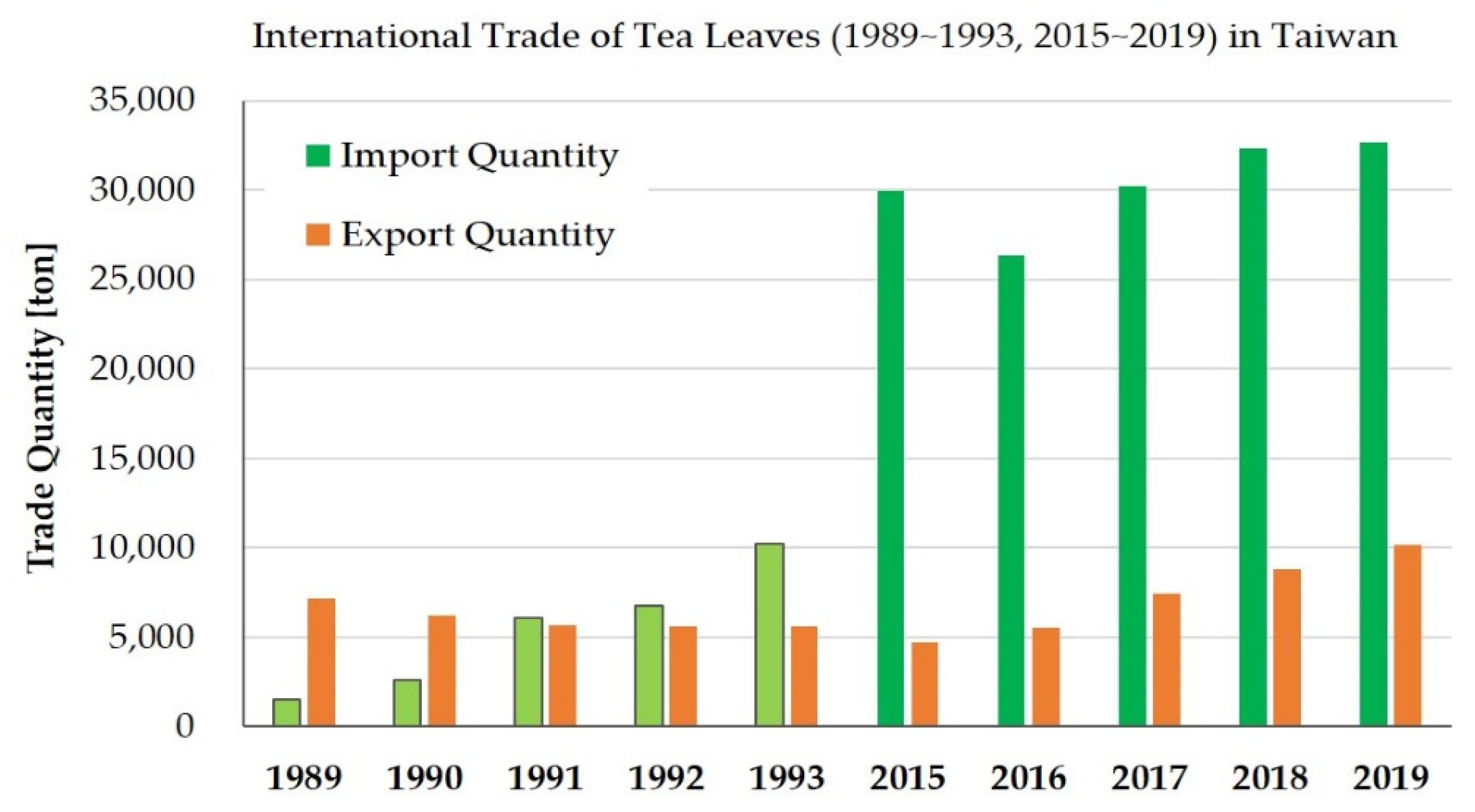
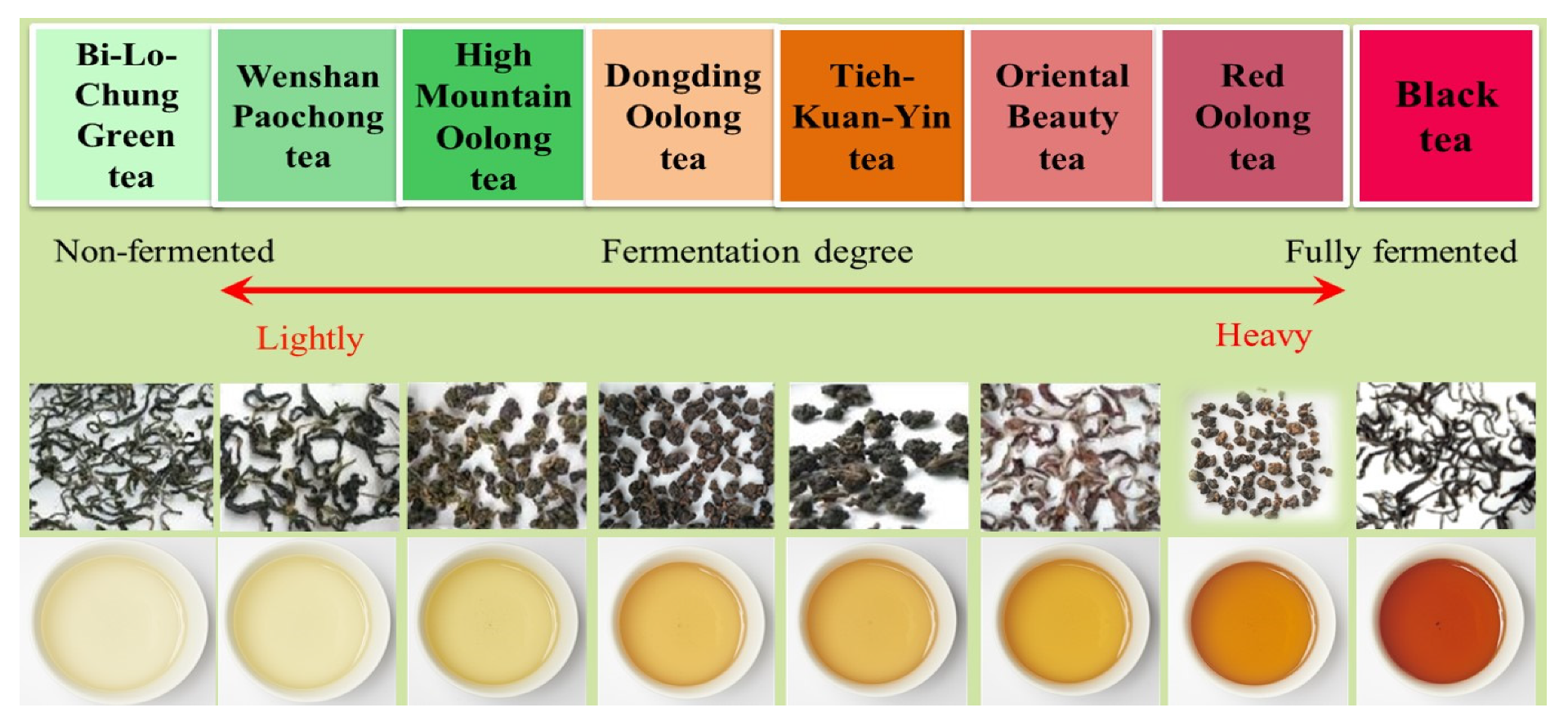
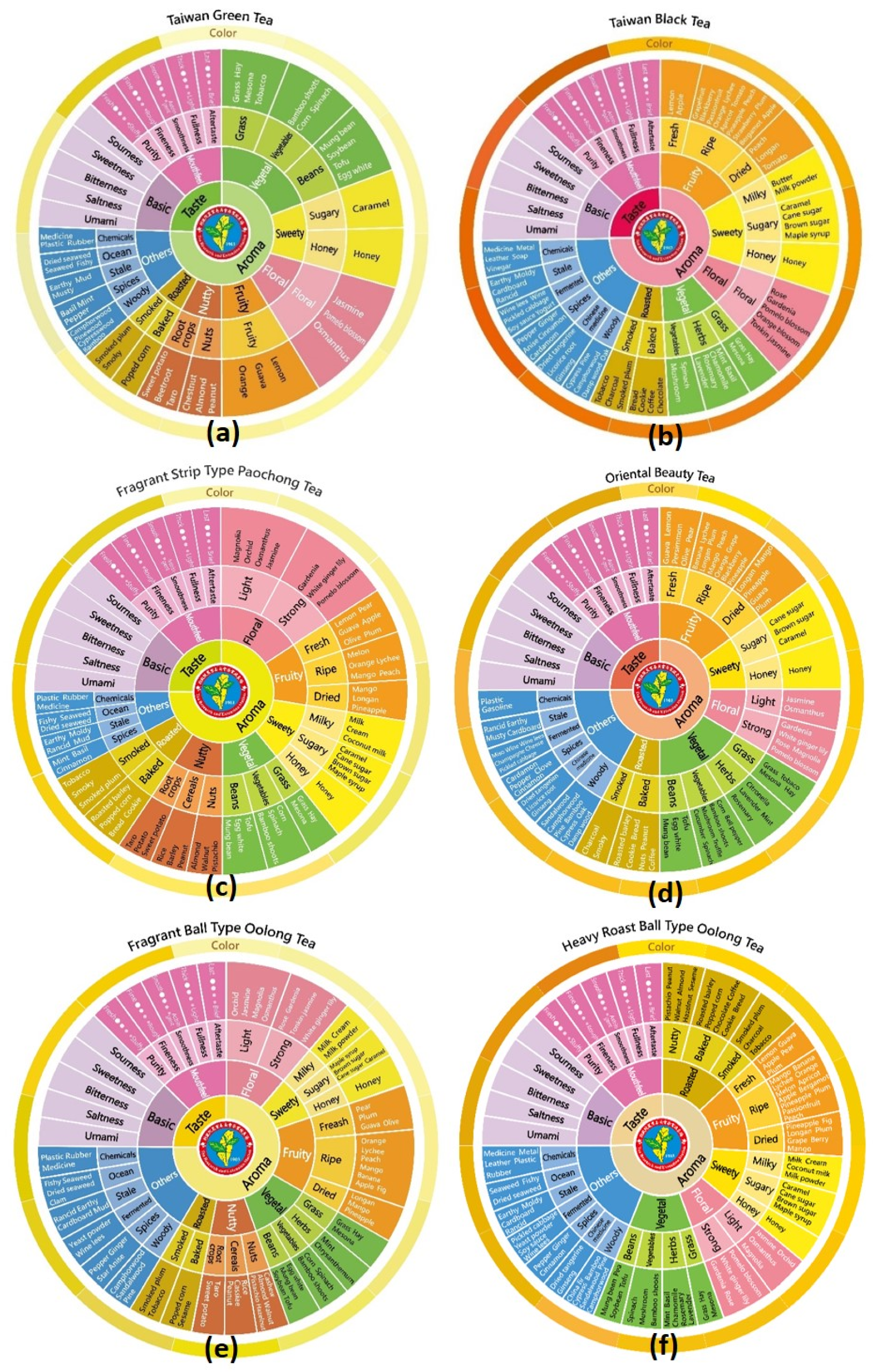
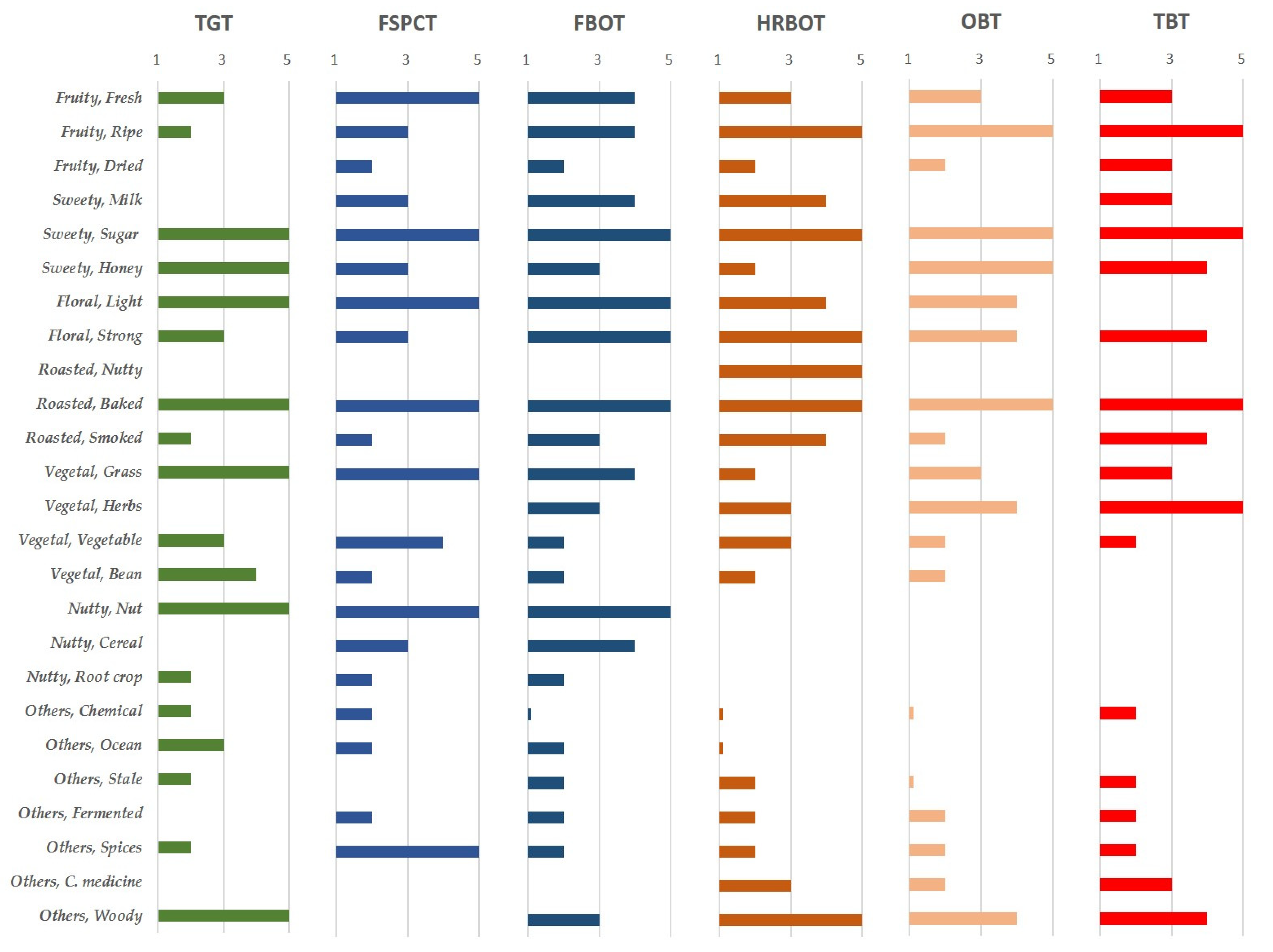
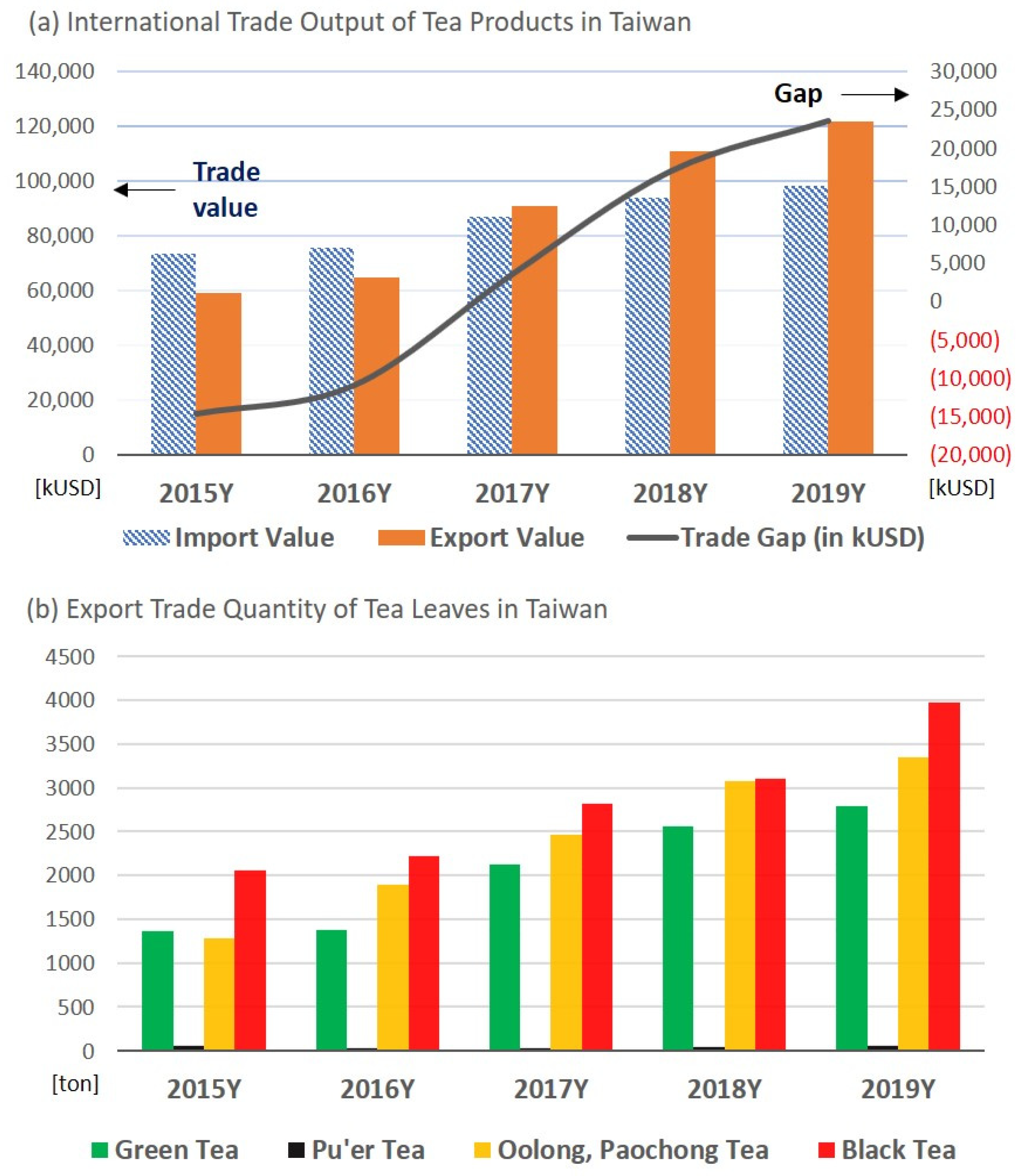
| Specialty Tea | Samples | Brewing Time | Flavor Category |
|---|---|---|---|
| Bi-Luo-Chun | 40 | 5 min | Taiwan green tea |
| Wenshan-Paochong | 50 | 5 min | fragrant strip-type Paochong tea |
| High-Mountain Oolong | 73 | 6 min | fragrant ball-type Oolong tea |
| Dongding Oolong | 169 | 6 min | heavy roast ball-type Oolong tea |
| Tieh-Kuan-Yin | 19 | 6 min | heavy roast ball-type Oolong tea |
| Red Oolong | 22 | 4 min | heavy roast ball-type Oolong tea |
| Oriental Beauty | 62 | 5 min 30 s | Oriental Beauty tea |
| Black tea | 60 | 5 min | Taiwan black tea |
| TGT 1 | FSPCT 1 | FBOT 1 | HRBOT 1 | OBT 1 | TBT 1 | |
|---|---|---|---|---|---|---|
| Color Attribute | ||||||
| Color atlas of infusion | 10 | 11 | 12 | 14 | 16 | 12 |
| Taste Attribute | ||||||
| Basic (Sour, Sweet, Bitter, Salt, Umami) | 5 | 5 | 5 | 5 | 5 | 5 |
| Mouthfeel (Purity, Fine, Smooth, Full, Aftertaste) | 5 | 5 | 5 | 5 | 5 | 5 |
| Aroma Attribute | ||||||
| Fruity | 4 | 16 | 18 | 26 | 21 | 21 |
| (Fresh, Ripe, Dried) | (2, 2, 0) | (7, 6, 3) | (5, 9, 4) | (5, 13, 8) | (5, 11, 5) | (2, 15, 4) |
| Sweet | 3 | 10 | 8 | 10 | 4 | 8 |
| (Milk, Sugar, Honey) | (0, 2, 1) | (3, 6, 1) | (3, 4, 1) | (4, 5, 1) | (0, 3, 1) | (2, 5, 1) |
| Floral | 3 | 8 | 11 | 12 | 8 | 5 |
| (Light, Strong) | (2, 1) | (4, 4) | (4, 7) | (5, 7) | (3, 5) | (-, 5) |
| Roasted (Nutty, Baked, Smoked) | 3 | 9 | 7 | 23 | 9 | 8 |
| (-, 1, 2) | (-, 6, 3) | (-, 4, 3) | (7, 9, 7) | (-, 7, 2) | (-, 4, 4) | |
| Vegetal (Grass, Herbs, Vegetable, Bean) | 12 | 13 | 15 | 22 | 22 | 12 |
| (3, -, 5, 4) | (3, -, 6, 4) | (4, 2, 5, 4) | (3, 6, 8, 5) | (6, 6, 7, 3) | (3, 5, 4, -) | |
| Nutty (Nut, Cereal, Root crop) | 6 | 9 | 8 | 0 | 0 | 0 |
| (3, -, 3) | (3, 3, 3) | (5, 3, 2) | (-, -, -) | (-, -, -) | (-, -, -) | |
| Others | ||||||
| Chemical | 3 | 3 | 3 | 5 | 2 | 5 |
| Ocean | 3 | 3 | 5 | 3 | - | - |
| Stale | 3 | 4 | 4 | 4 | 4 | 4 |
| Fermented | - | - | 2 | 4 | 6 | 5 |
| Spices | 3 | 3 | 3 | 3 | 4 | 5 |
| Chinese medicine | - | - | - | 2 | 3 | 4 |
| Woody | 4 | - | 3 | 6 | 7 | 5 |
| Aroma descriptors 2 | 58 | 87 | 99 | 131 | 100 | 92 |
Publisher’s Note: MDPI stays neutral with regard to jurisdictional claims in published maps and institutional affiliations. |
© 2021 by the authors. Licensee MDPI, Basel, Switzerland. This article is an open access article distributed under the terms and conditions of the Creative Commons Attribution (CC BY) license (https://creativecommons.org/licenses/by/4.0/).
Share and Cite
Su, T.-C.; Yang, M.-J.; Huang, H.-H.; Kuo, C.-C.; Chen, L.-Y. Using Sensory Wheels to Characterize Consumers’ Perception for Authentication of Taiwan Specialty Teas. Foods 2021, 10, 836. https://doi.org/10.3390/foods10040836
Su T-C, Yang M-J, Huang H-H, Kuo C-C, Chen L-Y. Using Sensory Wheels to Characterize Consumers’ Perception for Authentication of Taiwan Specialty Teas. Foods. 2021; 10(4):836. https://doi.org/10.3390/foods10040836
Chicago/Turabian StyleSu, Tsung-Chen, Meei-Ju Yang, Hsuan-Han Huang, Chih-Chun Kuo, and Liang-Yü Chen. 2021. "Using Sensory Wheels to Characterize Consumers’ Perception for Authentication of Taiwan Specialty Teas" Foods 10, no. 4: 836. https://doi.org/10.3390/foods10040836
APA StyleSu, T.-C., Yang, M.-J., Huang, H.-H., Kuo, C.-C., & Chen, L.-Y. (2021). Using Sensory Wheels to Characterize Consumers’ Perception for Authentication of Taiwan Specialty Teas. Foods, 10(4), 836. https://doi.org/10.3390/foods10040836






